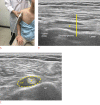Therapeutic efficacy of low-dose steroid combined with hyaluronidase in ultrasonography-guided intra-articular injections into the shoulder for adhesive capsulitis
- PMID: 34399045
- PMCID: PMC8446488
- DOI: 10.14366/usg.20199
Therapeutic efficacy of low-dose steroid combined with hyaluronidase in ultrasonography-guided intra-articular injections into the shoulder for adhesive capsulitis
Abstract
Purpose: The purpose of this study was to compare the efficacy of low-dose steroid, highdose steroid, and low-dose steroid combined with hyaluronidase with respect to intra-articular injection therapy for adhesive capsulitis (AC) of the shoulder.
Methods: Thirty patients with primary AC in the initial stage were randomly assigned into three groups to receive ultrasound-guided intra-articular injections with 20 mg of triamcinolone acetonide (group A, n=10), 40 mg of triamcinolone acetonide (group B, n=10) and 20 mg of triamcinolone acetonide combined with hyaluronidase (group C, n=10). The outcome measures included a visual analogue scale (VAS), the Shoulder Disability Questionnaire (SDQ), abduction and external rotation range of motion, and intra-sheath fluid (ISF) before treatment and at 2, 4, 8, and 16 weeks after treatment.
Results: Among the 30 patients, one participant in group B dropped out; therefore, a total of 29 patients completed this study and were successfully injected. After the injection, the VAS, SDQ, range of flexion and external rotation, and ISF improved in all groups compared with the preinjection status, regardless of treatment or time point. In the comparison between groups, the SDQ and ISF showed significantly greater improvements in groups B and C than in group A.
Conclusion: The therapeutic efficacy of combined low-dose corticosteroid and hyaluronidase is superior to that of low-dose corticosteroid and equivalent to that of high-dose corticosteroid in early AC.
Keywords: Adhesive capsulitis; Hyaluronidase; Intra-articular injections; Steroids; Ultrasonography.
Conflict of interest statement
No potential conflict of interest relevant to this article was reported.
Figures




Similar articles
-
Optimal dose of intra-articular corticosteroids for adhesive capsulitis: a randomized, triple-blind, placebo-controlled trial.Am J Sports Med. 2013 May;41(5):1133-9. doi: 10.1177/0363546513480475. Epub 2013 Mar 18. Am J Sports Med. 2013. PMID: 23507791 Clinical Trial.
-
Effectiveness of radial extracorporeal shock-wave therapy versus ultrasound-guided low-dose intra-articular steroid injection in improving shoulder pain, function, and range of motion in diabetic patients with shoulder adhesive capsulitis.J Shoulder Elbow Surg. 2020 Jul;29(7):1300-1309. doi: 10.1016/j.jse.2020.03.005. J Shoulder Elbow Surg. 2020. PMID: 32553435 Clinical Trial.
-
Comparison of high- and low-dose corticosteroid in subacromial injection for periarticular shoulder disorder: a randomized, triple-blind, placebo-controlled trial.Arch Phys Med Rehabil. 2011 Dec;92(12):1951-60. doi: 10.1016/j.apmr.2011.06.033. Epub 2011 Oct 25. Arch Phys Med Rehabil. 2011. PMID: 22030233 Clinical Trial.
-
Current Role of Intra-Articular Injections of Platelet-Rich Plasma in Adhesive Capsulitis of Shoulder: A Systematic Review.Bioengineering (Basel). 2022 Dec 22;10(1):21. doi: 10.3390/bioengineering10010021. Bioengineering (Basel). 2022. PMID: 36671593 Free PMC article. Review.
-
Effectiveness of corticosteroid injections in adhesive capsulitis of shoulder: A meta-analysis.Medicine (Baltimore). 2017 Jul;96(28):e7529. doi: 10.1097/MD.0000000000007529. Medicine (Baltimore). 2017. PMID: 28700506 Free PMC article. Review.
Cited by
-
Effect of intra-articular hyalase, Ketorolac, marcaine and triamcinolone, versus Ketorolac, marcaine and triamcinolone for reducing knee joint pain other than joint replacement.J Family Med Prim Care. 2022 Sep;11(9):5135-5139. doi: 10.4103/jfmpc.jfmpc_1982_21. Epub 2022 Oct 14. J Family Med Prim Care. 2022. PMID: 36505594 Free PMC article.
-
Clinical Practice Guidelines for Diagnosis and Non-Surgical Treatment of Primary Frozen Shoulder.Ann Rehabil Med. 2025 Jun;49(3):113-138. doi: 10.5535/arm.250057. Epub 2025 Jun 30. Ann Rehabil Med. 2025. PMID: 40602400 Free PMC article.
-
Ultrasound Guıded Multisıte Injectıon Technıque in the Treatment of Frozen Shoulder.Arthrosc Tech. 2022 Sep 17;11(10):e1823-e1826. doi: 10.1016/j.eats.2022.06.020. eCollection 2022 Oct. Arthrosc Tech. 2022. PMID: 36311325 Free PMC article.
-
Pharmacological interventions for early-stage frozen shoulder: a systematic review and network meta-analysis.Rheumatology (Oxford). 2024 Dec 1;63(12):3221-3233. doi: 10.1093/rheumatology/keae176. Rheumatology (Oxford). 2024. PMID: 38538951 Free PMC article.
References
-
- Fields BK, Skalski MR, Patel DB, White EA, Tomasian A, Gross JS, et al. Adhesive capsulitis: review of imaging findings, pathophysiology, clinical presentation, and treatment options. Skeletal Radiol. 2019;48:1171–1184. - PubMed
-
- Ahn JH, Lee DH, Kang H, Lee MY, Kang DR, Yoon SH. Early intraarticular corticosteroid injection improves pain and function in adhesive capsulitis of the shoulder: 1-year retrospective longitudinal study. PM R. 2018;10:19–27. - PubMed
-
- Shaffer B, Tibone JE, Kerlan RK. Frozen shoulder: a long-term follow-up. J Bone Joint Surg Am. 1992;74:738–746. - PubMed
LinkOut - more resources
Full Text Sources
Medical

